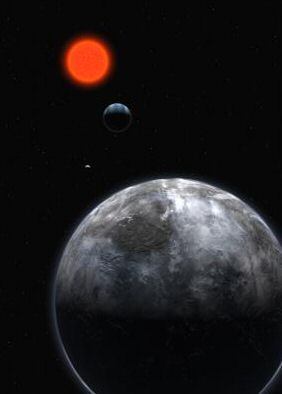30 September 2010
Newly discovered exoplanet may be habitable
by Kate Melville
 Planet hunters from the University of California, Santa Cruz, and the Carnegie Institution of Washington have discovered an Earth-sized planet orbiting a nearby star at a distance that places it in the "Goldilocks zone" (the orbital zone conducive to harboring life), where liquid water could exist and human habitation might be possible.
Planet hunters from the University of California, Santa Cruz, and the Carnegie Institution of Washington have discovered an Earth-sized planet orbiting a nearby star at a distance that places it in the "Goldilocks zone" (the orbital zone conducive to harboring life), where liquid water could exist and human habitation might be possible.
The new planet orbits the red dwarf star Gliese 581 which is located about 20 light years away from Earth in the constellation Libra. The new discovery brings the total number of known planets around Gliese 581 to six, the most yet discovered in a planetary system other than our own solar system. Like our own solar system, the planets around Gliese 581 have nearly circular orbits.
The Goldilocks-zone planet is known as Gliese 581g, which has a mass three to four times that of the Earth and an orbital period of just under 37 days. Its mass indicates that it is probably a rocky planet with enough gravity to hold on to an atmosphere.
Gliese 581 has a somewhat checkered history of habitable-planet claims. Two previously detected planets in the system lie at the edges of the habitable zone, one on the hot side (Gliese 581c) and one on the cold side (Gliese 581d). While some astronomers still think planet d may be habitable if it has a thick atmosphere with a strong greenhouse effect to warm it up, others are skeptical. The newly discovered planet g, however, lies right in the middle of the habitable zone.
To astronomers, a "potentially habitable" planet is one that could sustain life, not necessarily one that humans would consider a nice place to live. Habitability depends on many factors, but liquid water and an atmosphere are among the most important.
"Our findings offer a very compelling case for a potentially habitable planet," said Steven Vogt, professor of astronomy and astrophysics at UC Santa Cruz. "The fact that we were able to detect this planet so quickly and so nearby tells us that planets like this must be really common."
Gliese 581g is tidally locked to the star, meaning that one side is always facing the star and basking in perpetual daylight, while the side facing away from the star is in perpetual darkness. One effect of this is to stabilize the planet's surface climates, explains Vogt. The most habitable zone on the planet's surface would be the line between shadow and light (known as the "terminator"), with surface temperatures decreasing toward the dark side and increasing toward the light side. "Any emerging life forms would have a wide range of stable climates to choose from and to evolve around, depending on their longitude," Vogt said.
The researchers estimate that the average surface temperature of the planet is between -24 and 10 degrees Fahrenheit (-31 to -12 degrees Celsius). Actual temperatures would range from blazing hot on the side facing the star to freezing cold on the dark side.
If Gliese 581g has a rocky composition similar to the Earth's, its diameter would be about 1.2 to 1.4 times that of the Earth, says Vogt, adding that surface gravity would be about the same or slightly higher than Earth's.
The new discovery has implications for the number of stars that are likely to have at least one potentially habitable planet. Given the relatively small number of stars that have been carefully monitored by planet hunters, this discovery has come surprisingly soon.
"If these are rare, we shouldn't have found one so quickly and so nearby," Vogt said. "The number of systems with potentially habitable planets is probably on the order of 10 or 20 percent, and when you multiply that by the hundreds of billions of stars in the Milky Way, that's a large number. There could be tens of billions of these systems in our galaxy."
Related:
Astronomers detect distant solar system with five planets
Expolanet's winds blow at 10,000 kmh
Scientists mull polarized light tell-tales from alien life
Source: University of California - Santa Cruz
